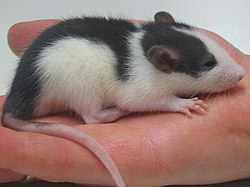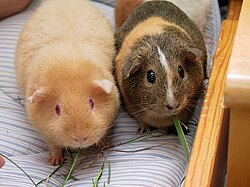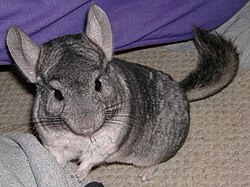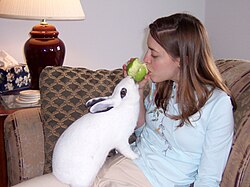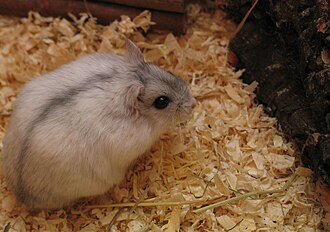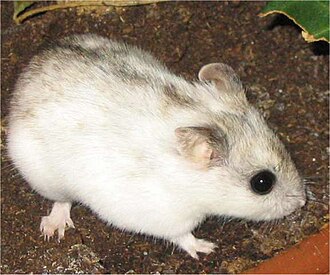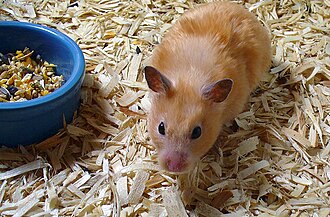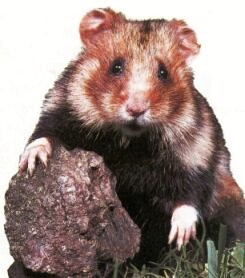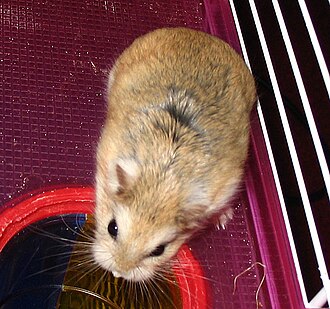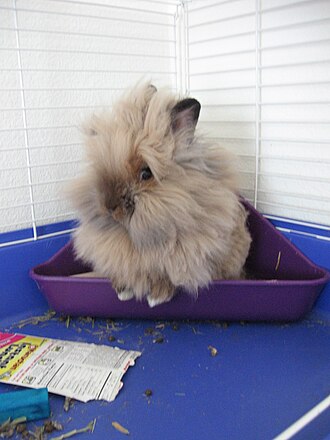AY Honors/Small Mammal Pets/Answer Key
Template:Honor header Template:AY Master
1. Have the Mammal Honor.
2. Keep a small mammal pet for at least six months. (Dogs and cats are not included as small mammal pets.) For a suggested list of pets to choose from, see #5 below.
Keeping a pet represents a tremendous commitment on the part of the owner. Pets rely on their owners for their most basic needs, and if the owner is neglectful, or "just doesn't feel like" taking care of the animal, it will suffer. Some small mammal pets have a lifespan of only a couple of years, which is fairly short as compared to other pets. Because of the limited lifespan, a small mammal as a first pet would be a good choice for a parent to test a child's commitment. However, that should not relieve a child (or any pet owner) of responsibly caring for the animal.
If you realistically believe you can make a multi-year commitment to a small mammal pet, then you should go for it. Just make sure you have your parent's and landlord's permission. Having a pet is not only an enjoyable experience, it may help you grow as a person.
3. Complete one of the following:
a. If you currently have a small mammal pet, keep a record of the care for your small mammal for one month. Include in your record when it is watered, fed, and when its cage is cleaned.
b. If you do not currently have a small mammal pet, but you have kept one for at least six months, “babysit” someone else’s small mammal pet for at least one week. Record the care that was required.
Adventist Youth Honors Answer Book/Pet care records
4. Give an oral report (at least 3 minutes) on what you have observed about your small mammal pet. Include favorite foods, some of its habits, when it is most active, and favorite story about pet, etc.
This report could be given during Sabbath School, during club worship, or told as a children's story during church. It can also be given to your unit during a club meeting. Use the records kept in the previous requirement to help you prepare. Three minutes is not a very long report, so do not let that make you nervous. Once you start talking about your pet, the three minutes will pass before yo uknow it.
5. a. Be able to distinguish between the following groups of small mammal pets:
(1) Hamster
Hamsters are stout-bodied, with tails much shorter than body length and have small furry ears, short stocky legs, and wide feet. Their thick, silky fur, which can be long or short, can be black, grey, white, brown, buff, yellow, "sapphire" or red depending on the species, or a mix of any of those colors. Dwarf desert hamsters (genus Phodopus) are the smallest, with bodies 5 to 10 cm (about 2 to 4 inches) long; the largest is the common hamster (Cricetus cricetus), measuring up to 34 cm long, not including a short tail of up to 4 cm. The tail is often difficult to see; usually it is not very long, and on a long haired hamster it is barely visible.
(2) Gerbils
Gerbils are typically between six and twelve inches (150 to 300 mm) long, including the tail which makes up approximately one half of their total length. One species however, the Great Gerbil, or Rhombomys opimus, originally native to Turkmenistan, can grow to more than 16 inches (400 mm) in length. It is illegal to purchase, import or keep a gerbil as a pet in the U.S. State of California.
(3) Rats
The length can be up to 25 cm (10 in), with the tail a further 25 cm (10 in), the same length as the body. Adult body weight averages 350 g (12 oz) in males and about 250 g (9 oz) in females, but a very large individual can reach 500 g (18 oz). A rat's tail is for the most part hairless.
(4) Mice
Fancy mice is a term to describe mice that have been selectively bred for pet or for show. They can vary greatly in size, from small pet mice that are approximately 16–18 cm (6.3–7.1 in) long from nose to the tip of the tail, to show mice that measure 30 cm (12 in) nose to tail. Pet mice weigh about 25–40 g (0.88–1.4 oz) but large show mice can weigh up to 100 g (3.5 oz).
Human-directed artificial selection in fancy mice has created a variety of colors and patterns. These include black, chocolate, blue, white, cream, lilac, red, fawn, champagne, cinnamon, golden agouti, silver agouti, silver and dove. All mouse standards fall into one of five categories: Selfs (one solid color all over), Tans (mice of one solid color on the top with a tan belly), Marked either in Even or Broken patterns (spotting of a standard color on a base of white) and a miscellaneous category.
(5) Guinea pigs
Guinea pigs are large for rodents, weighing between 700 and 1200g (1.5-2.5 pounds), and measuring between 20 and 25 cm (8–10 inches) in length. They typically live an average of four to five years, but may live as long as eight years. According to the 2006 Guinness Book of Records the longest living guinea pig survived 14 years, 10.5 months
In Western societies, the guinea pig has enjoyed widespread popularity as a household pet since its introduction by European traders in the 16th century. Their docile nature, their responsiveness to handling and feeding, and the relative ease of caring for them, continue to make the guinea pig a popular pet. Organizations devoted to competitive breeding of guinea pigs have been formed worldwide, and many specialized breeds of guinea pig, with varying coat colors and compositions, are cultivated by breeders.
(6) Chinchillas
Chinchillas are rabbit-sized rodents native to the Andes mountains in South America. They have large ears and long, bushy tails.
Domestic chinchillas can be kept as pets. Chinchillas are active at dusk and at dawn. They typically do not like to be disturbed during the day, which may make them less favorable as pets to some people. Chinchillas are naturally very skittish creatures and generally do not like to be held, although they can become very attached to their owners if they grow up without a cage mate. Because of their high-strung disposition, they are not usually considered to be good pets for small children. However, chinchillas can be very friendly animals if sufficiently acclimated to human touch as kits, making them excellent pets for patient owners.
(7) Rabbits
A house rabbit is a domestic rabbit kept as a pet for companionship, who lives inside the home with his owners.
(8) Ferrets
Domestic ferrets typically have brown, black, white, or mixed fur, have an average length of approximately 20 inches (51 cm) including a 5 inch (13 cm) tail, weigh about 2-4 pounds (1 kg), and have a natural lifespan of 7 to 10 years.
Being so closely related to polecats, ferrets are quite easily able to hybridize with them, and this has occasionally resulted in feral colonies of ferret polecat hybrids that have been perceived to have caused damage to native fauna, perhaps most notably in New Zealand. As a result, some parts of the world have imposed restrictions on the keeping of ferrets.
Note: If the list of domesticated small mammals above are not found in your area you may substitute local domesticated small mammals from your area.
b. Describe the basic care for one of the above list and describe one way the care of another one of the list differs from the one you selected.
Ferrets, alone of the animals on this list are carnivores. Because of this their care will differ from that of all the others here. If you selected a ferret, compare its care to any of the others. If you selected something else, compare its care to that of the ferret.
All of these pets need to have a supply of fresh water available to them at all times. Their cages should be kept clean, and theyq all require daily exercise.
Hamster
Template:Adventist Youth Honors Answer Book/Small Pet Care
Gerbils
Template:Adventist Youth Honors Answer Book/Small Pet Care
Rats
Template:Adventist Youth Honors Answer Book/Small Pet Care
Mice
Template:Adventist Youth Honors Answer Book/Small Pet Care
Guinea pig
Template:Adventist Youth Honors Answer Book/Small Pet Care
Chinchilla
Template:Adventist Youth Honors Answer Book/Small Pet Care
Rabbit
Template:Adventist Youth Honors Answer Book/Small Pet Care
Ferret
Template:Adventist Youth Honors Answer Book/Small Pet Care
c. Which two of these pets are not rodents?
Rodent are characterized by two continuously-growing teeth in the upper and lower jaws which must be kept short by gnawing (the "dent" in rodent is the same root as in "dentist"). Rabbits were once classified as rodents, but were moved into a new order called Lagomorphs in 1923. Ferrets belong to the weasel family.
6. Write a 200 word essay on the history and value of one of the above and what characteristics they have that make them good pets.
Go to the library an check out a book on the pet you are interested. You can also read an encyclopedia article about the animal:
Once you know some interesting facts, put them in writing. Use your own words. Two-hundred words will easily fit on a half page of letter-size paper.
7. Be able to identify five varieties of hamsters and five varieties of rabbits.
Hamsters
Winter White Russian Dwarf Hamster
They are very small, measuring only slightly over three inches and weighing less than an ounce.
Features include a typically thick dark grey dorsal stripe and furry feet. The tail is so short that it hardly shows when the hamster is sitting. As winter approaches and the days shorten, Winter Whites' dark fur greys until it is almost completely white (hence the name).
Winter Whites are often found on the pet market, in Europe and Asia more so than in North America and indeed are rarely found in pet stores in Canada. Winter White hamsters make good pets for teens or adults, not for younger children. They are not likely to bite but do not like to be cuddled or held. Due to a hamsters poor eyesight the risk of falling or jumping off your hand is high.
Chinese Hamster
Their average size is 3-4 inches. They are unique because of their tails, which are unusually long for a hamster. They actually resemble a mouse, and have a long slender body.
The wild color is greyish brown above with a black stripe down the spine and a whitish belly. This coloration, combined with their lithe build and longer tail, makes them look "mousy" to some eyes and, in fact, they are members of the group called ratlike hamsters. Besides the wild colour, a well-known variation is the white-spotted Chinese hamster, which often is greyish white all over, with only a dark stripe on its back.
Syrian Hamster
Their size is approximately 6-7 inches in length with a very short tail. It has hairless feet with four toes on the front feet and five on the back feet. Like most members of the subfamily, the Syrian Hamster has expandable cheek pouches, which extend from its cheeks to its shoulders. In the wild, hamsters are larder hoarders; they use their cheek pouches to transport food to their burrows.
Syrian Hamsters are wildly popular as house pets due to their docile, inquisitive nature and small size. They are popular as "first pets" for young children, as well as being classroom animals, because of their hardiness and relative ease of care. Some pet owners find them more attractive than rats and other rodents due to their lack of visible tails. However, their lack of tolerance towards each other is seen by some as a drawback.
European Hamster
They are the largest of all hamster species, being similar in size to guinea pigs, measuring up to 10 inches long. The black-bellied hamster is found from Belgium (e.g. Bertem with a thriving population) and Alsace in the west, to Russia in the east, and Romania in the south.
European hamsters are much larger than the Syrian hamsters or dwarf hamsters commonly kept as pets, being around 10-15 cm longer than guinea pigs.
In captivity, the European hamster has an unusually long life span, living up to eight years. They are very rarely kept as pets and have been known to attack large dogs if they feel threatened.
Roborovski hamster
Roborovski's (Phodopus roborovskii) are the smallest and fastest of all hamsters commonly kept as pets. Distinguishing characteristics of the Roborovskis are the white spots where the eyebrows would be, and the lack of the dorsal stripe seen in all other dwarf hamsters. They live, on average, to three and a half years of age. Recently, a mutation has arisen producing a "husky", also known as "white-faced", phase. Breeding these lines with agouti Roborovskis produces a diluted appearance of their natural sandy color.
Romanian hamster
The average size is 7-8 inches.
Rabbits
Dutch rabbit
The Dutch rabbit is a small-medium size rabbit with a stocky body and a short rounded head. The Dutch rabbit has a white inverted V shaped blaze that extends from its nose tapering up to a point between its ears. The front and back legs are white. The coat is short and dense.
French lop rabbit
The French lop rabbit has a stocky body with sturdy, fairly short legs. The coat is dense and soft and slightly long.
A French Lop is a type of rabbit that was first developed in France in the 1800s out of a breeding between the English Lop and the Flemish Giant. The French Lop differs from the English in that it is characterized by a heavier stature and shorter ears. The French Lop weighs in at around ten pounds and comes in two color varieties: solid and broken. It can be found in many different rabbit colors.
The French Lop must follow a balanced feeding habit. They should have a sizeable amount of dry rabbit food, which contains all the nutrition standardized for a healthy rabbit.
A French Lop is able to live outside and inside, a water-proof hutch that shelters the rabbit from any rain, snow, or heat is acceptable. If inside, a hutch or a cage can be used. If you are not giving your Lop regular time to spend with, consider getting two rabbits, a lonely rabbit that does not get regular exercise or companionship can be anti-social and depressed.
Lionhead rabbit
The lionhead rabbit is small rabbit with a stocky body. The coat is dense and of medium length with a mane of long hair circling its head.
Lionhead rabbit is one of the newest breed of domesticated rabbits. It has particularly long hair surrounding the face, reminiscent of the mane of a male lion, hence the name. Other characteristic traits of the lionhead include a rounded head and small size, usually between 2.5 and 3.5 pounds. It also tends to have slightly shorter ears than most breeds.
The Lionhead rabbit originated in Belgium. It is reported to have been produced by breeders trying to breed a long coated dwarf rabbit by crossing a miniature Swiss Fox and a Belgian dwarf. The Lionhead seemed to have been more popular than the long coated dwarf, and so breeders carried on this trend in breeding them intentionally, and so came what we know today as the Lionhead rabbit.
The Lionhead has a well-rounded body, head bold with well developed muzzle. Their legs are of medium length and not too fine in bone. Their ears do not exceed 3 inches in length. Their mane is between 2-3 inches in length to form a full circle around the head, extending to a 'V' at the back of the neck falling into a fringe between the ears. Noticeably longer hair on the cheeks and chest. The coat is dense and of medium length, roll back and even all over body in Adults.
Netherland dwarf rabbit
The Netherland dwarf rabbit has a small compact body and a short neck. The ears are small, erect, rounded at the tips. The coat is short and soft.
The Netherland Dwarf is a popular breed of domestic rabbit (Oryctolagus cuniculus) originating in the Netherlands. Smaller than most rabbit breeds, Netherland Dwarf rabbits weigh 1.6 to 2 kg and are usually kept as pets or exhibition animals.
Most rabbits sold in pet stores are Netherland Dwarfs, Netherland Dwarf-derived breeds (often referred to simply as dwarf breeds), or Netherland Dwarf crosses. Their popularity as pets stems from their babyish appearance and their smaller cage space requirement compared to larger rabbit breeds. A lot of people also use Netherland Dwarfs for showing.
Netherland Dwarfs' heads and eyes are disproportionately large with respect to their bodies, and their ears are tiny and carried high on the head. Additionally, their faces are rounded and shortened. These features, a part of the animals' dwarfism, cause them to look infantile even into adulthood.
Dwarf crosses frequently retain some of these characteristics, depending on the breed the dwarf is crossed with. However, crosses rarely look as babyish as the purebred dwarfs and are usually somewhat larger.
Netherland dwarf rabbits have the same basic behavioral traits as other domestic rabbits. They can be litter-trained but are generally not very good with cats or dogs.
They tend to have spunkier and more energetic temperaments than larger breeds of rabbit and are rarely content to sit still when outside of the cage. They are curious animals and have a tendency to nibble on nearby objects and even human beings. However, they are extremely fragile animals and easily stressed, and as such they do not make good pets for young children.
Polish rabbit
The Polish rabbit is compact but elegant with slender legs. The head is small and rounded and the ears are small, and erect. The coat is short, fine and thick.
Today, the Polish rabbit is used as a fancy exhibition breed. They are small rabbits with short ears that touch each other all the way to the tips. Due to their small size, the Polish rabbit is often confused with the Netherland dwarf, although the Polish is a little larger and the head is not rounded. (There are many other differences between the two breeds, such as coat structure and colors.) The accepted weights of the polish are two to three and 1/2 pounds. The ideal weight is 2.5.
Until the 1950s, most Polish rabbits were white with either red eyes or blue eyes. The red-eyed white is a true albino. The blue-eyed white has the Vienna white gene and is not a true albino. Since the 1950s, colored Polish breeds have been recognized by rabbit clubs. In 1957, the American Rabbit Breeder’s Association approved the black and chocolate Polish. In 1982, the blue variety was approved and in 1998 the broken variety was allowed.
Because of their small size, Polish rabbits need less space in cage and barn facilities, and take up less space in apartments than some of the larger bunnies. As with other small breed rabbits, they tend to be higher strung than their larger counterparts. They are also not ideal pets for small children as they are easily dropped, injured and stepped on. Their high-strung nature makes them more suited for a mature, rabbit-loving, adult home. However, the polish rabbit is not usually mean. Bucks are little clowns and are extremely fast if you let it loose good luck catching it, but they generally calm down at about two years of age. Does tend to be reserved in personality.
8. Why is it not good to make pets out of small mammals taken from the wild?
- Diet
- Wild animals do not eat the same foods as humans or domestic animals. It may not be possible for you to feed them what they need. If they do not get proper nutrition, they will not remain healthy.
- Legal Concerns
- It is illegal to keep wild pets in many localities. If you capture a wild animal and try to keep it as a pet, you may very well be breaking the law.
- Not Abandoned
- When people find baby animals that are apparently abandoned and attempt a "rescue," they are usually only interfering with the animal's life. In the vast majority of cases, the mother is nearby, and will return to it. Taking the baby animal in no way rescues it at all.
- Releasing
- Many people believe that when they get tired of their wild pet, they can merely release it back into the wild. However, if the animal was in captivity from youth, it will not have learned any survival skills, making this move a death sentence for the animal. Further, the animal's diet will necessarily have to change which will cause digestive problems. Remember, wild animals and domestic animals do not eat the same foods. This animal will hav undergone two major dietary shifts - the first when it was captured, and the second when it was released.
- Proper Care is Nearly Impossible
- It is nearly impossible to meet all the requirements a wild animal needs for survival. Many wild animals require specialized care in facilities staffed by highly trained professionals. A wild animal will almost never develop affection for its owner, and because it is wild, can turn on its keeper in an instant, causing serious injury, or possibly even death.
- Babies Grow Up
- Baby animals grow up. They are not usually as cute when they are fully grown, and most people greatly underestimate the strength of an adult wild animal. Given the change, it can easily overpower a human being. As they grow, their appetites grow too, and can often be accurately described as voracious. An adult wild animal can eat you out of house and home!
- Disease
- According to the Humane Society of the United States:
- The Centers for Disease Control and Prevention (CDC) discourages direct contact with wild animals for a simple reason: They can carry diseases that are dangerous to people, such as rabies, herpes B virus, and Salmonella. - http://www.hsus.org
9. Rabies: What is it? How is it spread? Can you get rabies from small mammals? Is it curable? How can you avoid getting it? Which small mammal pets can carry it?
Rabies is a viral disease that causes inflammation of the brain (encephalitis). If untreated, it is always fatal.
The virus is usually present in the nerves and saliva of a symptomatic rabid animal. The route of infection is usually, but not necessarily, by a bite.
Any mammal may become infected with the rabies virus and develop symptoms, including humans. Most animals can be infected by the virus and can transmit the disease to humans. Infected bats, monkeys, raccoons, foxes, skunks, cattle, wolves, dogs or cats provide the greatest risk to humans. Rabies may also spread through exposure to infected domestic farm animals, groundhogs, weasels and other wild carnivores. Squirrels, rodents and rabbits are seldom infected.
Rabies can be prevented by vaccination, both in humans and other animals. Virtually every infection with rabies was a death sentence, until Louis Pasteur and Emile Roux developed the first rabies vaccination in 1885. This vaccine was first used on a human on July 6, 1885 – nine-year old boy Joseph Meister (1876–1940) had been mauled by a rabid dog. Treatment after exposure is highly successful in preventing the disease if administered promptly, within fourteen days after infection. The first step is immediately washing the wound with soap and water, which is very effective at reducing the number of viral particles. In the United States, patients receive one dose of immunoglobulin and five doses of rabies vaccine over a twenty-eight day period. One-half the dose of immunoglobulin is injected in the region of the bite, if possible, with the remainder injected intramuscularly away from the bite. This is much less painful compared with administering immunoglobulin through the abdominal wall with a large needle, which is how it was done in the past.
Currently pre-exposure immunization has been used on domesticated and normal non-human populations. In many jurisdictions, domestic dogs, cats, and ferrets are required to be vaccinated. A pre-exposure vaccination is also available for humans, most commonly given to veterinarians and those traveling to regions where the disease is common, such as India. Most tourists do not need such a vaccination, just those doing substantial non-urban activities. However, should a vaccinated human be bitten by a carrier, failure to receive subsequent post-exposure treatment could be fatal, although post-exposure treatment for a vaccinated human is far less extensive than that which would normally be required by one with no pre-exposure vaccination.
All mammals can carry rabies, and this includes small mammal pets.
10. Why should you not handle your small mammal pets when you have a cold?
Guinea pigs, rats, and mice are used extensively in medical research because they are susceptible to many of the same diseases and virus as humans. Having a cold means you are infected with a Rhinovirus, a virus that can make all of these animals sick. When you have a cold, you can easily spread germs to others (that's probably how you caught the cold in the first place), whether they are human, or animal. Do your family, friends, and pets a favor, and wash your hands frequently, especially if a cold is going around or if you have one yourself. And if you do have one, stay away from small mammal pets!
11. Find in the Bible three references to animals that we now consider to be small mammal pets. According to the Bible, are they considered to be clean or unclean meat?
Three references can be found in these two verses.
The rabbit, though it chews the cud, does not have a split hoof; it is unclean for you.
"'Of the animals that move about on the ground, these are unclean for you: the weasel, the rat, any kind of great lizard, the gecko, the monitor lizard, the wall lizard, the skink and the chameleon."
References
- Humane Society of the United States - Hamster care
- http://www.twinsqueaks.com/guide.php - Gerbil care
- http://www.altpet.net/rodents/rats/ratfaq.html
External Links
- http://www.ferretcare.org/
- Ferret Information - Ferret care
- Ferret Care


